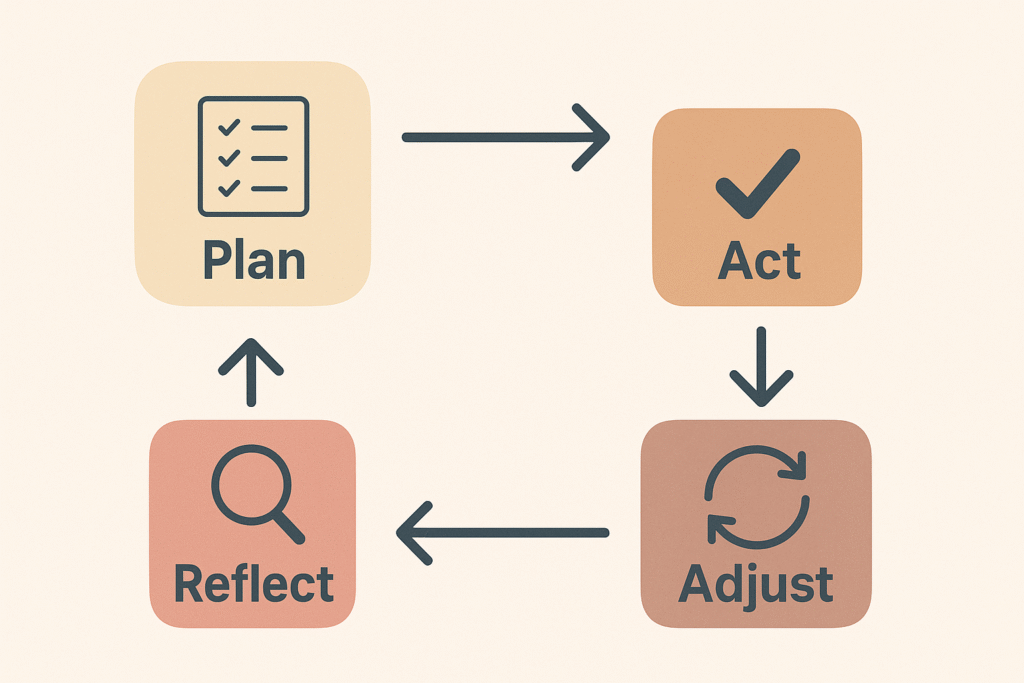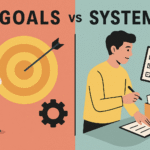Systems vs Goals: Why Systems Work Better for Long-Term Success
At the beginning of this year, I started out with a vision board and big goals. I mapped out targets, visualized outcomes, and built timelines. The plan looked solid—on paper. But reality quickly reminded me of a truth I’ve encountered time and time again: big goals don’t guarantee consistent progress.
This wasn’t new for me. For years, this was my default approach. I set goals for everything: the grades I wanted in school, the weight I wanted to lose, the milestones I wanted to hit in my career. Some I achieved. Most I didn’t. And over time, I started to realize something important: it wasn’t the goals that made the difference—it was the systems behind them.
The more I paid attention, the more I realized this pattern wasn’t just personal—it was universal. The people who actually made progress weren’t obsessing over outcomes—they were committed to the process. A writer might dream of publishing a bestselling book, but it’s the habit of writing 500 words a day that gets the manuscript finished. A job seeker might aim to land their dream role, but it’s the daily rhythm of refining their resume, networking, and applying strategically that creates momentum. Even someone trying to improve their mental health might start with a goal of “feeling better,” but it’s the consistent habits—like journaling, therapy, or taking daily walks—that actually lead to emotional growth. The breakthrough always comes from the system, not just the intention.

At the beginning of this year, I started out with a vision board and big goals. I mapped out targets, visualized outcomes, and built timelines. The plan looked solid—on paper. But reality quickly reminded me of a truth I’ve encountered time and time again: big goals don’t guarantee consistent progress.
This wasn’t new for me. For years, this was my default approach. I set goals for everything: the grades I wanted in school, the weight I wanted to lose, the milestones I wanted to hit in my career. Some I achieved. Most I didn’t. And over time, I started to realize something important: it wasn’t the goals that made the difference—it was the systems behind them.
The more I paid attention, the more I realized this pattern wasn’t just personal—it was universal. The people who actually made progress weren’t obsessing over outcomes—they were committed to the process. A writer might dream of publishing a bestselling book, but it’s the habit of writing 500 words a day that gets the manuscript finished. A job seeker might aim to land their dream role, but it’s the daily rhythm of refining their resume, networking, and applying strategically that creates momentum. Even someone trying to improve their mental health might start with a goal of “feeling better,” but it’s the consistent habits—like journaling, therapy, or taking daily walks—that actually lead to emotional growth. The breakthrough always comes from the system, not just the intention.
That’s when the difference between goals and systems finally clicked for me. Goals are about the results you want. Systems are about the actions you take to get there. A goal might be to get fit; the system is committing to daily movement and meal planning. A goal might be to grow on YouTube; the system is scripting, filming, and posting consistently. Goals give you direction—but systems give you traction. And in my experience, it’s the system that determines whether you actually make progress or stay stuck in a cycle of starting over.
The Problem With Goals
The problem with goals is that they often set us up for frustration. They create a finish line, and until we cross it, we feel like we’re falling short. I’ve had goals that looked exciting at the start but left me drained halfway through—either because they felt too far off or because life threw me off course. Goals can be fragile. Miss one deadline, skip one week, and suddenly the whole plan feels broken. They also delay our sense of progress—we tell ourselves we’ll feel successful when we hit the goal, instead of recognizing the growth happening along the way.
Why Systems Work Better
That’s where systems changed everything for me. Unlike goals, systems aren’t tied to a single outcome—they’re built around consistency. They give you something to fall back on when motivation fades or life gets chaotic. A solid system doesn’t punish you for missing a day; it welcomes you back the next. It focuses your attention on the process instead of the pressure. And most importantly, systems are flexible. You can refine them, improve them, and adapt them as you grow. It’s not about perfection—it’s about showing up and letting progress compound.
From Goals to Systems: What It Looks Like
Here’s what that shift looked like in real life. Instead of setting a vague goal like “get fit,” I focused on walking 30 minutes a day and prepping meals every Sunday. Rather than saying “grow my online brand,” I committed to publishing two YouTube Shorts weekly and repurposing content for my blog. “Learn data analysis” turned into a system of studying one hour each day, building mini-projects, and sharing progress online. These weren’t flashy or perfect, but they were consistent—and over time, the results followed the rhythm I created.
How to Build a System That Works
If you want to start building your own system, don’t overcomplicate it. Start with the outcome in mind, but shift your focus to the daily behaviors that would naturally lead there. Ask yourself: What’s the smallest, most repeatable action I can commit to? Make it so simple that it’s nearly impossible to fail. Then track your effort—not your results. Did you show up today? Did you take the step? That’s what matters. Over time, small consistent actions stack up in ways that big, overwhelming goals never could.
Identity: The Hidden Power of Systems
One of the most powerful effects of systems is the way they reshape identity. When you consistently show up, even in small ways, you stop saying “I want to be” and start believing “I am.” You don’t just run—you become a runner. You don’t just post—you become a creator. The shift in behavior rewires how you see yourself, and identity change is what makes the habit stick. The more you practice a habit, the more you reinforce the identity behind it. That’s the real engine behind long-term transformation.
What If Your System Stops Working?
Of course, no system is perfect from the start. Sometimes the actions are too ambitious, or life changes and your routine needs adjusting. That’s okay. Instead of quitting, revisit the process. Ask yourself: Is this realistic for my current season? Can I scale it down to make it sustainable? Can I batch tasks or automate parts of it? Systems aren’t static—they’re living tools that should evolve with you. One of the best things you can do is review your system monthly. Keep what’s working. Fix what isn’t.
Key Takeaways
- Goals are useful for direction—but systems are what drive progress.
- Focus on small, repeatable actions you can do consistently.
- Design systems that are flexible, sustainable, and aligned with your identity.
- You don’t need to be perfect—you just need to keep showing up.
- Progress doesn’t come from intensity. It comes from consistency.
Final Thoughts
Looking back, I’ve learned that success doesn’t come from obsessing over the finish line—it comes from learning to love the process. You don’t need to set bigger goals—you need to build better systems. Start small, stay consistent, and trust the compound effect. Whether you’re trying to grow your skills, your career, or your confidence, the climb matters more than the summit.


